“Nothing brings people together like a warm pot of chicken stew.” I read that once on a rainy day, and boy, did it hit home. When life feels cold or chaotic, I always turn to this rustic, flavorful bowl of comfort. In fact, 86% of people say stew is their go-to cold-weather dish!
Whether you’re a stew newbie or a seasoned slow cooker pro, this guide will warm your heart and boost your cooking game. From ingredient tips to slow-cooked secrets, you’re about to learn everything needed to make chicken stew your signature comfort dish.
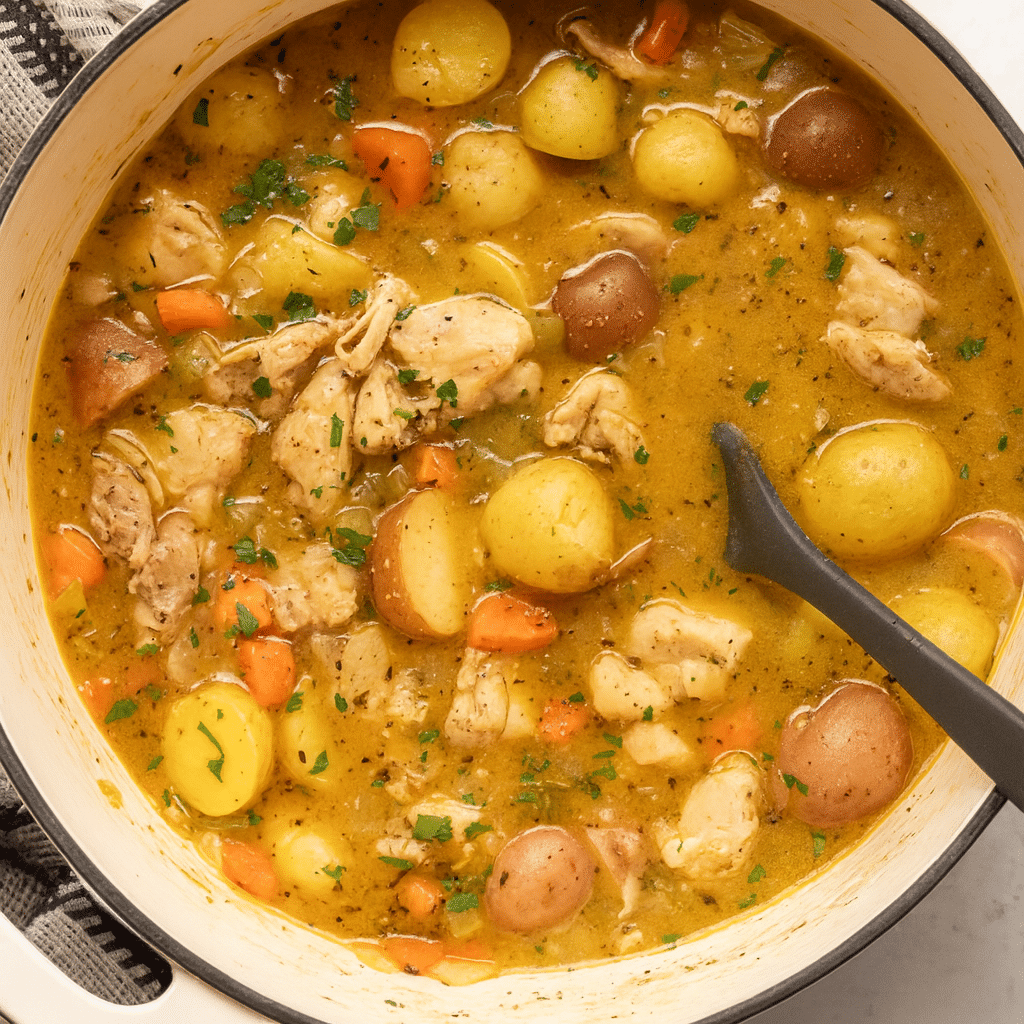
Choosing the Right Chicken for Stew
Alright, let me be real with you—I used to think all chicken was the same. Like, chicken is chicken, right? Wrong. One cold Sunday, I made a stew with boneless skinless breast, and it turned out… honestly, it was awful. Dry, rubbery, and totally flavorless. That’s when I learned: the cut of chicken can completely change the game.
Thighs Are the Gold Standard
If you’re chasing that rich, fall-apart tenderness, you want chicken thighs. Bone-in, skin-on if possible. That bone? It adds crazy depth to your broth. And the skin? It gives you that velvety mouthfeel in the stew, especially if you let it crisp a bit before simmering. I usually render the fat off in the pan first—gets everything tasting like it cooked all day, even if it didn’t.
Why I Rarely Use Breasts Anymore
Now look, I’ve used chicken breasts when I had to. But they dry out so fast. One minute they’re fine, and the next they’re stringy and chalky. If you do use them, cut ’em into big chunks and don’t let them simmer forever. Better yet, toss them in halfway through the cook. Still not as good as thighs, though—just being honest.
Does Organic Make a Difference?
Short answer: yeah, kinda. I tested it once, side by side—store-brand drumsticks versus organic air-chilled thighs. The organic ones had this subtle, deeper flavor. A little cleaner. A little sweeter. Not essential, but if you’re cooking for someone special or just feel like splurging, it’s a nice upgrade.
Cut Size Matters More Than You Think
One thing I totally messed up in the past? Chopping the chicken too small. I used to think bite-sized meant tiny. Nope. Those little bits dry out in minutes. Now I go with medium chunks—enough to hold together after a long simmer but still easy to scoop with a spoon. Big enough to taste the difference.
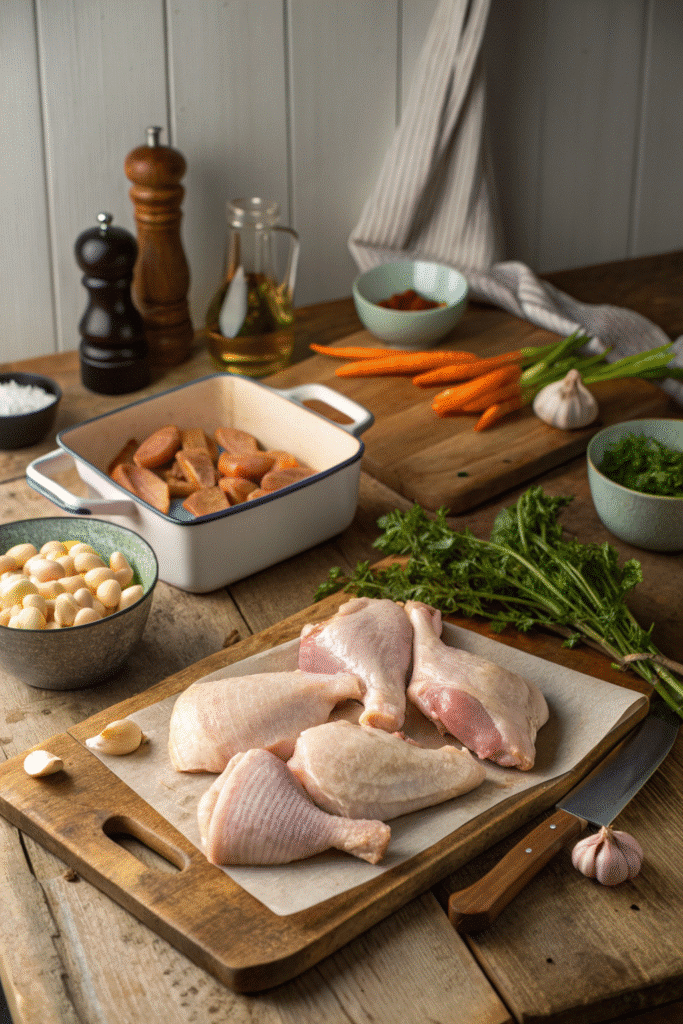
Essential Vegetables and Herbs to Include
You know that saying, “The stew’s only as good as what you put in it”? Totally true. I used to treat veggies like filler—just toss in whatever was in the fridge. But once I started paying attention to which ones I used, and when I added them, everything changed.
The Big Three: Carrots, Onions, and Potatoes
These three are the backbone. Carrots bring sweetness. Onions mellow everything out and give that subtle depth. And potatoes? They soak up flavor like sponges. I prefer Yukon Golds—they hold up better than russets, which can get all mushy if you’re not careful.
I learned the hard way once, dumping in chopped russets and walking away. Came back to a pot full of what looked like mashed potatoes and chicken soup. Not great.
Celery? Don’t Skip It
I used to think celery was optional. Like, who really tastes it in stew? Turns out, when you skip it, you miss that background flavor that ties everything together. I dice it small so it almost melts into the broth. Same with parsnips, if you want to level up—just a little gives it this earthy, old-school flavor.
Garlic and Bay Leaves: Trust the Process
I always start my stew by sautéing garlic—low heat, don’t burn it. Adds a whole layer of flavor that raw garlic just can’t touch. Bay leaves are a must too. I use two. Don’t ask why, it just feels right. Take ’em out before serving though. I bit one once. Never again.
Fresh Herbs or Dried?
If I have fresh thyme or rosemary, I tie it into a little bundle with twine and drop it in. Fancy? Maybe. Worth it? Absolutely. But dried works too—just use a light hand. Rosemary especially. That stuff can take over if you’re not careful. Been there. Had to fish out leaves one by one while pretending dinner was going great.
Seasonal Swaps
In winter, I’ll sometimes toss in turnips or a handful of kale at the end. Makes it feel a little healthier and gives the stew more body. Leeks are another secret weapon. Swap them for onions if you want a slightly sweeter, more delicate flavor.
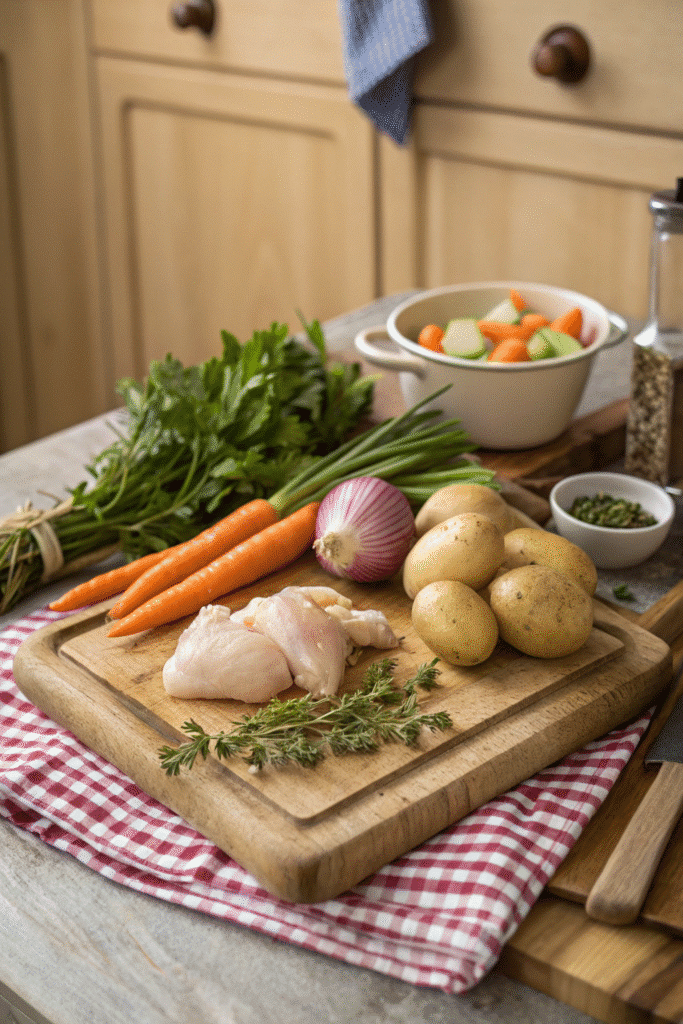
Step-by-Step Chicken Stew Cooking Method
I used to think stew was just a dump-and-go thing—throw it all in a pot, walk away, come back to magic. Not quite. The order you do things in? It matters. A lot. It took me a few bland, oddly textured pots of stew to figure that out. Here’s how I do it now, and it never fails.
Start by Browning the Chicken
This is where you build your base. I heat up oil—sometimes a bit of butter too—in a heavy-bottomed pot, usually a Dutch oven. Then I brown the chicken in batches. Don’t crowd the pot, or it’ll steam. You want that golden crust. That’s flavor. Leave the brown bits in the bottom of the pot. They’re stew gold.
One time I skipped this and just boiled the chicken with everything else. Never again. It tasted like dishwater and sadness.
Sauté the Aromatics Next
After removing the chicken, I toss in diced onions, carrots, celery—whatever aromatics I’m using. Let ’em sweat for a few minutes to pull up all those brown bits. I add garlic last so it doesn’t burn. If you’re using tomato paste or any spices, now’s the time to stir them in and let them toast for a minute.
Add the Chicken Back In, Then the Liquid
Once the veggies are soft, I add the chicken back in and pour in the broth. I like to use homemade if I have it, but boxed low-sodium chicken broth works too. I usually toss in bay leaves and herbs here too. Bring it up to a boil, then immediately drop the heat.
Low and slow is key. You want it just barely simmering. If it’s bubbling like crazy, the chicken gets tough and the veggies fall apart too fast. I learned that the hard way trying to speed things up once. Don’t do it.
Timing Matters
I let it simmer uncovered for a bit—usually 30 to 45 minutes depending on the size of the chicken pieces. If it’s a lazy Sunday, I’ll go longer. More time equals deeper flavor. I wait to add potatoes and delicate stuff like kale or peas until the last 20 minutes. That way, everything’s perfectly tender but not mushy.
Thicken It—Or Don’t
Some people like their stew brothy. Others want it thick. I’m in the middle. If I want it thicker, I mix a tablespoon of flour or cornstarch with cold water and stir it in near the end. Sometimes I just let it reduce naturally with the lid off. It depends on my mood and how hungry everyone is.
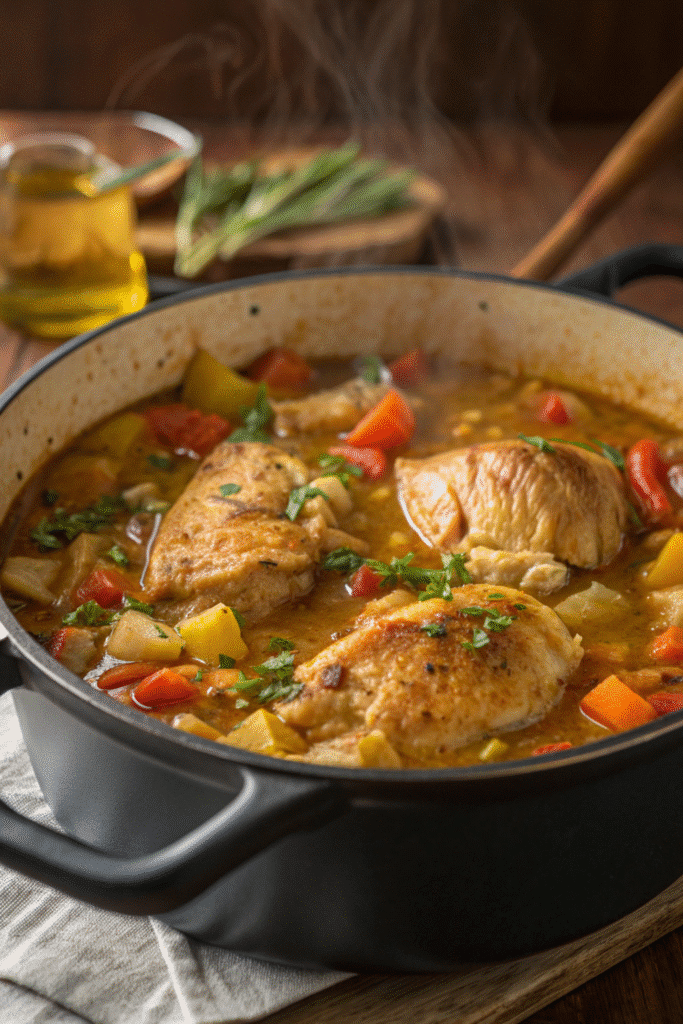
Common Mistakes to Avoid When Making Chicken Stew
Let me tell you, I’ve messed up chicken stew in just about every way possible. And every time, I learned something that made the next batch better. If you’re new to this—or even if you’ve made it a dozen times—here are the biggest mistakes I’ve made so you don’t have to.
Overcooking the Veggies
My first couple of stews looked like baby food. I’d throw everything in at once and let it simmer for hours. Carrots turned to mush. Potatoes practically dissolved. Now, I add heartier vegetables early, but anything delicate—peas, kale, even some herbs—I wait till the end. They only need 10–15 minutes, max.
Undersalting the Broth
This one’s sneaky. You taste your stew halfway through and think it’s fine, then by the time it’s done? Bland city. Chicken absorbs a ton of salt while it cooks. So now, I season in layers. A little when I brown the meat, a little when I sauté the veggies, and then again toward the end. Always taste before serving.
Funny enough, once I thought the stew was too salty, and I tried to fix it with sugar. Big mistake. It tasted like someone dropped a caramel in it.
Rushing the Simmer
Chicken stew isn’t fast food. It needs time to come together. I tried to crank the heat once ‘cause I was starving, and all it did was dry out the meat and make the veggies fall apart. Low heat and patience—that’s the secret sauce.
Forgetting the Acid
This is a game changer. I went years without realizing my stew needed a splash of brightness at the end. Now I always finish with a squeeze of lemon or a tiny bit of vinegar. Just a bit. You don’t really taste it, but it makes the whole thing pop. Like turning up the contrast on a photo.
Not Skimming the Fat
I used to skip this because I thought it didn’t matter. But man, even a couple spoonfuls of fat floating on top can make the stew feel heavy and greasy. So I skim it off before serving. If I’m feeling extra, I even make it the day before and chill it overnight—makes it super easy to remove the solidified fat.

Serving Ideas & Storage Tips for Leftovers
The first bowl of chicken stew is always great, sure—but it’s what you do with the leftovers that takes it to legendary status. I didn’t used to think about this stuff. I’d toss the pot in the fridge, forget about it, and then find it a week later… moldy and sad. Now I’ve got a system.
What to Serve With It
I used to throw a piece of toast on the side and call it dinner. These days, I go a little further. Crusty bread—like a sourdough baguette—is perfect for soaking up the broth. Sometimes I’ll ladle the stew over rice or even mashed potatoes if I have leftovers. It feels like a whole new meal.
Oh, and if you’ve never tried it with a side of roasted green beans or a simple arugula salad? Do it. Adds some freshness to balance the richness of the stew.
Reheating Without Drying It Out
This was a big one for me. I used to microwave leftovers straight from the fridge and wonder why the chicken turned rubbery. Now I reheat it on the stove over low heat. Add a splash of water or broth to loosen things up. Stir it gently. Takes a little longer, but it’s so worth it.
Freezing Tips That Actually Work
Not all containers are created equal. I learned the hard way when I defrosted a stew that tasted like freezer burn. Now I portion it into individual servings using freezer-safe glass containers. Label and date everything. Don’t just write “stew”—add the type and the date or you’ll end up with a frozen mystery meal.
One trick? Leave about half an inch of space at the top for expansion, or the lid might pop off. Happened once. It wasn’t pretty.
Make It Stretch for Meal Prep
Chicken stew is a dream for meal prepping. I’ll double the batch on Sunday, then portion it out with rice or bread for the week. Sometimes I’ll even turn it into a completely different meal. Like, I’ll thicken the leftovers and stuff it into a puff pastry for a quick pot pie. Or pour it into a baking dish, top with mashed potatoes, and boom—shepherd’s pie remix.
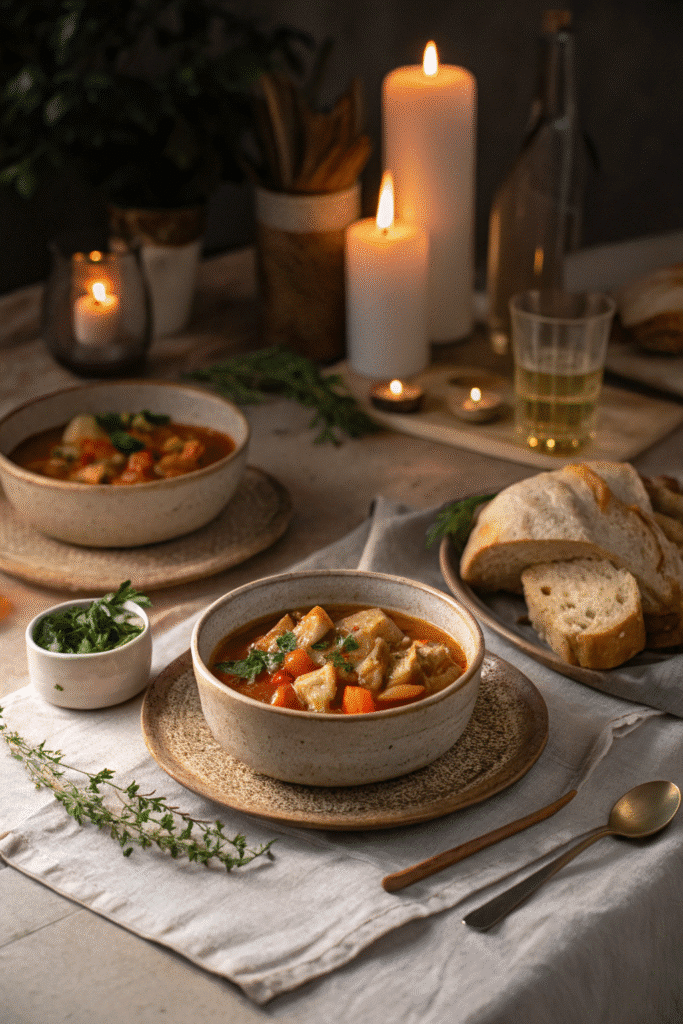
Chicken stew isn’t just a recipe in my kitchen—it’s a go-to ritual. Whether I’m cooking for my family on a slow Sunday or just need a hug in food form after a rough week, this dish always delivers. Over the years, I’ve learned it’s not about perfection. It’s about patience, layering flavor, and making something that feels like home.
If you’ve never made it from scratch before, trust me—give it a shot. Don’t worry if it doesn’t come out “just right” the first time. Mine sure didn’t. But each batch gets better, and soon enough, you’ll be riffing on it with your own twist.
So go ahead, make it your own. And if you found this guide helpful, I’d love it if you shared it on Pinterest. Let’s keep the stew love going. Happy cooking, and keep that pot simmering.
Print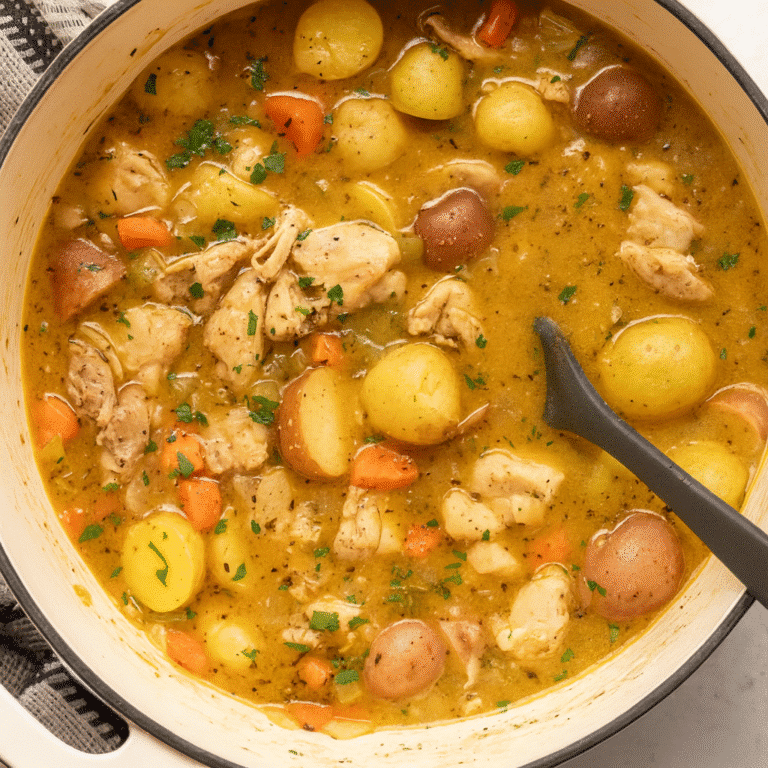
Cozy Up with This Ultimate Chicken Stew
Nothing brings people together like a warm pot of chicken stew. Whether you’re a newbie or seasoned pro, this cozy, flavor-packed recipe delivers the ultimate comfort.
- Total Time: 1 hour 20 minutes
- Yield: 6 servings 1x
Ingredients
- 2 lbs bone-in, skin-on chicken thighs
- 2 tbsp olive oil (or butter)
- 1 large onion, diced
- 3 carrots, peeled and chopped
- 3 celery stalks, diced
- 3 garlic cloves, minced
- 1 tbsp tomato paste (optional)
- 4 cups low-sodium chicken broth
- 2 bay leaves
- 4–5 medium Yukon Gold potatoes, chopped
- 1 tsp salt (adjust to taste)
- 1/2 tsp black pepper
- 1 tsp dried thyme or a bundle of fresh thyme
- 1 tsp rosemary (dried or fresh sprigs)
- 1 tsp vinegar or juice of 1/2 lemon
- Chopped parsley or fresh herbs to finish
Instructions
- Heat oil in a Dutch oven or heavy-bottomed pot over medium heat.
- Brown chicken thighs in batches on both sides. Remove and set aside.
- Add diced onions, carrots, and celery. Sauté until softened.
- Add garlic and optional tomato paste. Stir and cook briefly.
- Return chicken to pot. Pour in chicken broth. Add bay leaves and herbs.
- Bring to a boil, then reduce heat and let simmer gently uncovered for 30–45 minutes.
- Add chopped potatoes during the last 20 minutes of simmering.
- If a thicker stew is desired, mix 1 tbsp flour or cornstarch with cold water and stir in near the end.
- Season with salt and pepper in layers. Taste before serving.
- Finish with a splash of lemon juice or vinegar for brightness. Garnish with parsley.
Notes
Avoid overcrowding the pot when browning chicken. Add delicate veggies like peas or kale during the last 10–15 minutes. For best flavor, let stew rest or refrigerate overnight and reheat gently.
- Prep Time: 20 minutes
- Cook Time: 60 minutes
- Category: Comfort Food
- Method: Stovetop
- Cuisine: American
Nutrition
- Serving Size: 1 bowl
- Calories: 380
- Sugar: 4g
- Sodium: 620mg
- Fat: 18g
- Saturated Fat: 5g
- Unsaturated Fat: 12g
- Trans Fat: 0g
- Carbohydrates: 25g
- Fiber: 4g
- Protein: 28g
- Cholesterol: 95mg


